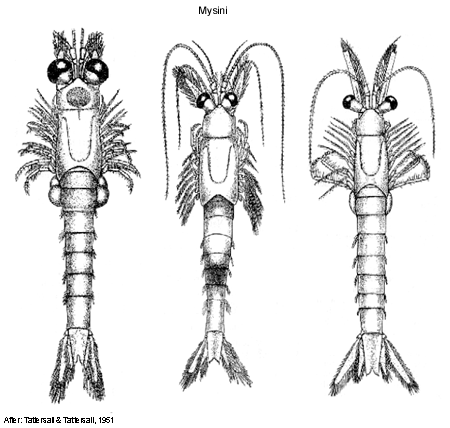 |
||||||
|
|
|
|
|
|
Mysidacea: Families, Subfamilies and TribesKenneth MelandMysini Haworth, 1825 Diagnostic description. Head. Carapace large, last 2 or 3 thoracic somites exposed dorsally. Rostrum obtuse, or broadly rounded. Eyes normally developed. Antenna (antenna 2) scale present (very variable), with apical suture or without apical suture, outer margin smooth, without setae or outer margin smooth, setose, with terminal spine or without terminal spine. Labrum symmetric. Mandible lacinia mobilis well developed, spine row present between lacinia mobilis and molar process, molar process well developed. Thorax. 1st maxilliped exopod well developed. 2nd thoracopod developed as a maxilliped, exopod well developed. 3rd thoracopod forming a pereopod. 3rd-8th thoracopods endopod with fused carpus and propodus (tarsus), carpopropodus divided into several subsegments. Branchiae on thoracopods absent. Marsupium composed of two pairs of oostegites (additional rudimentary oostegites may be found on the 5th and 6th thoracic limb). Abdomen 6th & 7th abdominal somites fused. 1st pair endopod reduced; 2nd pair rudimentary; 3rd pair reduced; 4th pair modified exopod (very long, subdivided into two to six segments), or modified endpod; 5th pair biramous, or reduced. Female pleopods uniramous or greatly reduced. Uropod endopod inner margin with robust setae, statocyst present; exopod complete, setose around entire margin. Telson apex entire, or apex cleft. Generic composition. Mysini contains 46 genera (263 species): Acanthomysis Czerniavsky, 1882 (47 species); Alienacanthomysis Holmquist, 1981 (1 species); Anisomysis Hansen, 1910 (45 species); Antarctomysis Coutiere, 1906 (3 species); Antromysis Creaser, 1936 (6 species); Arthromysis Colosi, 1924 (1 species); Caspiomysis G.O. Sars, 1907 (1 species); Columbiaemysis Holmquist, 1982 (1 species); Diamysis (Czerniavsky, 1882); (5 species); Disacanthomysis Holmquist, 1981 (1 species); Exacanthomysis Holmquist, 1981 (4 species); Halemysis Bacescu & Udrescu, 1984 (1 species); Hemimysis G.O. Sars, 1869 (9 species); Hippacanthomysis Murano & Chess, 1987 (1 species); Holmesimysis Holmquist, 1979 (5 species); Idiomysis Bacescu, 1968 (3 species); Indomysis W. Tattersall, 1914 (1 species); Inusitatomysis Ii, 1940 (1 species); Kainomatomysis W. Tattersall, 1927 (2 species); Katamysis G.O. Sars, 1893 (1 species); Limnomysis Czerniavsky, 1882 (1 species); Lycomysis Hansen, 1910 (3 species); Mesacanthomysis Nouvel, 1967 (1 species); Mesopodopsis Czerniavsky, 1882 (7 species); Mysidium (Dana, 1850); Tattersall, 1951 (7 species); Mysis Latereille, 1802 (13 species); Nanomysis W. Tattersall, 1921 (3 species); Neomysis Czerniavsky, 1882 (17 species); Nipponomysis Takahashi & Murano, 1986 (17 species); Orientomysis Derzhavin, 1913 (1 species); Pacifacanthomysis Holmquist, 1981 (1 species); Paracanthomysis Ii, 1936 (3 species); Paramesopodopsis Fenton, 1985 (1 species); Paramysis Czerniavsky, 1882 (21 species); Parastilomysis Ii, 1936 (4 species); Parvimysis Brattegard, 1969 (3 species); Platyops Bacescu & Iliffe, 1986 (1 species); Praunus Leach, 1814 (3 species); Proneomysis W. Tattersall, 1933 (1 species); Schistomysis Norman, 1892 (6 species); Stilomysis Norman, 1894 (3 species); Surinamysis Bowman, 1977 (3 species); Taphromysis Banner, 1953 (3 species); Tasmanomysis Fenton, 1985 (1 species); Troglomysis Stammer, 1933 (1 species); Xenacanthomysis Holmquist, 1980 (1 species). Remarks. The Mysini is the largest tribe of Mysidacea and are found inhabiting shallow water habitats worldwide. They are described from caves, rivers and lakes; and oceanic forms in brackish, littoral, and coastal waters. The tribe contains two of the most species rich genera of Mysidacea, the Acanthomysis with 47 species, and Anisomysis with 45 species, both genera abundant in coastal waters of the Indian and Pacific Ocean. Paramysis is frequently encountered in shallow waters of the Mediterranean, Caspian and Black Sea, while Schistomysis is well represented in the north Atlantic. The Mysini are recognized by the third to eighth thoracopods endopods having the propodus and carpus fused, secondarily divided into several subsegments, and the reduction of the first, second and fifth male pleopods. Due to large varition in morphology of antennal scales, uropods and telson, definitions of the Mysini genera is complicated and has lead to several revisions (Brattegard, 1970; Bowman, 1977; Bamber & Henderson, 1990).
Cite this publication as: 'Meland, K. (2002 onwards). Mysidacea: Families, Subfamilies and Tribes. Version 1: 2 October 2002. https://crustacea.net'. |
|
|
|
|
|
|
|
|
|
Copyright © Australian Museum, 2002 - 2003
Australian Museum website
